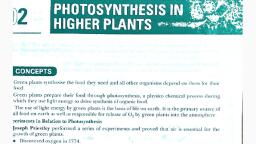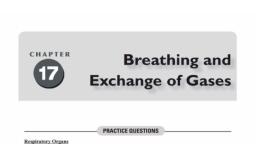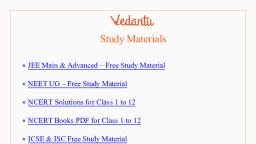Page 1 :
BR SRR RIS, , , , Breathing and Exchange of Gases 99, , ‘EARNING OUTCOMES, , his chapter is completed, the students should be able to, at ;, wre, , yj the organs of breathing/respiration in different groups of animals., « list, , , , , , jist the OZANS of respiration in humans and draw a labelled diagram of the respiratory system of, « is =, , man. . . a, plain the steps and mechanism of respiration., een, show diagrammatically the passage of air during the process ., jist and explain the different respiratory volumes and respiratory capacities., , explain the transport and exchange of respiratory gases., , + explain briefly the regulation of respiration., , + describe the disorders of respiratory system like asthama, emphysema, occupational disorders, etc., , IMPORTANT CONCEPTS, , 17.1. RESPIRATORY ORGANS © Reptiles, birds and mammals have lungs for, © The respiratory organs and the mechanism of respiration., , breathing depend on the habitat in which the 17,, , animals live and the levels of organisation., , -1. Human Respiratory System, , — Human respiratory system consists of a pair, , , , * Poriferans (sponges), coelenterates and of external nostrils, nasal cavity/chamber,, flatworms do not have any special organ/ nasopharynx, larynx, trachea, bronchi,, structure and exchange of gases takes place bronchioles and alveoli,, in them by simple diffusion over the entire — The external nostrils present just above the, body surface. upper lip lead into the nasal chamber through, , * Inearthworms, exchange of gases takes place the nasal passage., through the moist cuticle on the body. — The nasal chamber opens into the nasopharynx,, , ® Terrestrial arthropods have either a branched a part of the pharynx that leads into the, system of tubes, called tracheae or book-lungs larynx through the glottis; glottis is covered, , as their respiratory organs, by epiglottis during swallowing of food/water., | * Gills are the respiratory organs in molluscs, — — ate ae boxclike ete, aquatic arthropods, hemichordates, that _ in sound production; it leads into, | cephalochordates, urochordates and among the trae ne ., , | Vertebrates in fishes and tadpoles of frogs/ — Trachea is a straight tubular structure, that, toads, extends through the neck upto the mid-thoracic, , a. . cavity and divides at the level of the fifth, | Adult amphibians like frogs and toads have es . . :, Pulmonary § eas thoracie vertebra into two primary bronchi,, Te S S 5 . ‘ i, espiratio, Spication as; Well as cutaneous one of which enters the right lung and the, mM. ., other the left lung.
Page 2 :
oe, , 100 Agecder were? Biology —11, Epiglottie, , Larynx, Trachea, Ploural, , - = membranes, , Avveoli, , , , Bronchus:, , Bronchioles, , , , , , Diaphragm, , Fig. 17.1 Human Respiratory System, , — Each of the primary bronchus divides into a, number of secondary and tertiary bronchi., , ~ The tertiary bronchi give rise to initial, bronchioles and then the terminal bronchioles., , — The trachea, primary, secondary and tertiary, bronchi and initial bronchioles are provided, with incomplete (C-shaped) cartilaginous, , | rings., , — Each terminal bronchiole ends in a thin-walled,, highly vascularised, sac-like structure, called, alveolus., , t — The branching network of bronchi, bronchioles, and alveoli constitute the lungs., , — The lungs are covered by a double-layered, membrane called pleura, and pleural fluid, is present between the two layers of the, membrane, , — The outer membrane of pleura is in close, , | association with the inner lining of the, thoracic cavity, while the inner membrane, is in contact with the lung surface,, ‘The Jungs are located in the thoracic chamber,, ~ The part of the respiratory system extending, from the external nostrils to the termina|, bronchiole, is known as the conducting part, , AEE, , The alveoli and their ducts fe, 8 for, , or exchange part of the Fesp the te, Mato,, , Olves the 4,, , “Pita, — Pulmona i :, monary respiration iny, :, , steps: loys, vin, , (i) Breathing or Pulmonary y,, enti, which atmospheric air ig in, carbon dioxide-tich alvesig: a" % |, out. mane |, , (ii) Diffusion of gases O, and ¢o., the alveolar membrane, 2“, , (iit) Transport of gases in the blood, , (2) Diffusion of O, from blood int ti, and that of carbon dioxide from, tissues into blood., , , , , , (v) Utilisation of oxygen by the cells for, oxidation and release of CO,., , 17.2. MECHANISM OF BREATHING, © The movement of air into and out of the uns, is carried out by creating a pressure gradient, between the lungs and the atmosphere., © The diaphragm and the intercostal muscles, help in the generation of such a pressut, gradient., © Breathing involves two steps:, (i) Inspiration, during which air is de", into the lungs and :, (ii) Expiration, during which alveolar ait, sent out., A. Inspiration a, — Inspiration occurs whe!, pressure is less thal, pressure, /.¢., the intra-pu =, is negative compared '0 the, , the intra-pulmen, n the atmos?!, ssi, Imonary Ps, atmos?, , pressure., i ont), B. Expiration scp, — Expiration occurs W at oft, wher U, pressure is higher, , atmosphere., , hen the, han ¢
Page 3 :
(b) Expiration, , (a) Inspiration, , Fig. 17.2 Mechanism of Breathing, , 72.1, Respiratory Volumes, _ The volume of air involved in the breathing, , movements can be measured by using a, , spirometer., , A. Tidal Volume (TV), , » The volume of air inspired and expired, during normal, effortless breathing, is, called tidal volume., , It is approximately 500 ml., , 8. Inspiratory Reserve Volume (IRV), , * The extra volume of air that can be inspired, beyond the normal tidal volume, is called, inspiratory reserve volume., , ™ It is about 2500-3000 ml., , © Expiratory Reserve Volume (ERV), , ™ The extra volume of air, that can be, breathed out, beyond the normal tidal, Volume, is called expiratory reserve, Volume,, , is ., b, 18 volume is about 1000 ml to 1100 ml., Residual Volume (RV), , * The . oe, volume of air that remains in the, lungs, even, , Called residy, *, , US Value ay, , 1200 inf,, , after forceful expiration, is, al volume., rages between 1100 ml and, , , , Breathing and Exchange of Gases 101, , 17.2.2. Pulmonary capacities, , ~ When two or more of the respiratory volumes, are considered together, pulmonary capacities, are obtained., , A. Inspiratory Capacity (IC), , “» The volume of air that can be breathed, in by distending the lungs to a maximum,, beginning at normal expiratory level, is, called inspiratory capacity., , ‘™ It is the sum total of tidal volume and, inspiratory reserve volume, i.e.,, , IC = TV + IRV., , B. Functional Residual Capacity (FRC), , » When a person inhales and exhales in a, normal way, the volume of air that remains, in the lungs, is known as functional residual, capacity., , « It includes the residual volume and, expiratory reserve volume i.e.,, , FRC = RV + ERV., , C. Expiratory Capacity (EC), , » The volume of air that can be breathed, out forcefully after a normal inspiration,, is called expiratory capacity., , ‘™» It includes tidal volume and expiratory, reserve volume, i.e., EC = TV + ERV., , D. Vital Capacity (VC), , «» When a person inhales with maximum, effort and exhales also with maximum, effort, the volume of air breathed out, is, called vital capacity., , ™ It is the sum total of tidal volume,, inspiratory reserve volume and expiratory, reserve volume,, ie, VC = TV + IRV + ERV.,, , E, Total Lung Capacity, , » Total lung capacity refers to the volume, of air accommodated in the lungs at the, end of a forceful inspiration., , ES
Page 4 :
102 render were® Biology 1, , “1 is the sum total of tidal volume,, inspiratory reserve volume, expiratory, reserve volume and residual volume., TLE = TV + IRV + ERV + RV or VCE RY, , 17.3, EXCHANGE OF GASES, A. In the Alveoli, , Alveoli are the primary sites of exchange of, , respiratory gas, Oxygen and carbon dioxide are exchanged, by simple diffusion, based on their pressure, or concentration gradient., , — The thickness of the membranes involved and, the solubility of the gases, are the two major, factors that can affect the rate of diffusion., , BS., , , , Alveolar duct, , Alveolus, Alveolar, epithelium, Basement, membrane, Endothelium of, blood vessel, Red blood, corpuscle, , , , Fig. 17.3 Exchange between Alveolus, , and Capillaries, , , , — The diffusion membrane is made up of three, , major layers., (i) The squamous epithelium of alveoli., , (ii) The endothelium of alveolar capillaries., (iii) The basement membranes between them., , — The total thickness of the membrane is about, 0.2 mm., , ~ The factors are favourable for diffusion of, oxygen into the blood from the alveoli and, the diffusion of carbon dioxide from the, blood into the alveoli., , EY a, ff,, , B. In the Tissues, , In the metabolically Actiy,, 5 C ti, , is about 40 mm Hg, wh, , blood brought to the i, 95 mm Hg; so Ox, blood into the tiss, , , , Ue cells,, In the tissues, the Peo, is abe, which is higher than ‘that Ut 45 Mp, mm Hg); so carbon dioxi, , the tissues into the blood, , Mm Hy, , F the blood, ide diffuses bi, , 40), , om, , Inspired air, , , , , , Expired air, , , , , Alveolar air, , , , , , , , , , Alveolus, co, 0,, Pulmonary Pulmo, nat, artery vein, , Systemic Systemic, veins arteries, (Carrying (Carrying, deoxygenated oxygenated, blood) blood), Po, = 95 mmHg, , , , , Po, = 40 mm Hg, , Pco,= 45 mm Hg 0 mm Ha, , Body tissues, , Fig. 17.4 Exchange of Gases, N THE BLOO?, , , , 17.4. TRANSPORT OF GAS:, 17.4.1. Transport of Oxygen ., ~ About 97% of oxygen is transport’, erythrocytes in the form of oxyh, and 3% is carried in a dissol, the plasma., ~ Oxygen binds with t ©, haemoglobin in a reversible, form oxyhaemoglobin., , by, , naemoglob"", it, , ved fort
Page 5 :
', » Peo, less H, Por low Feo,, , and lo, your the binding of oxygen, , igh, pe We", pooner ation, , w he factors that fa), we, , wrth haemoe™, oglobin, = is Pes, , ssue where Po, Is low, Pco,, , H* concentration and high, hese factors favour the, , wer temperature are, , oglobin., , does not dissociate until, my, oxyhee!, , jt reaches 4 ti, is high. high, "ature exist; ¢, f oxyhaemoglobin., , every decilitre (100 ml) of blood, , can transport about 5 ml of oxyven to the tissues under normal, g, , remperatu, gigsociation ©, , physiological conditions., ji42 Transport of Carbon dioxide, / _ About 4 ml of carbon dioxide is transported, by every 100 ml of blood., ~ C0, is transported in three forms in the blood:, ()) In the dissolved form in plasma, (about 5-7%), ™ About 5 - 7% of CO, is carried in, the dissolved form in the plasma., ™ The remaining CO, enters the, erythrocytes., (ii) As bicarbonates (about 70%), ™ Erythrocytes have a high concentration of the enzyme, carbonic, anhydrase which catalyses the, following reactions;, co, +O == HCO,, 1,co, === H*+HCO,, Some of the bicarbonazte ions, diffuse into the cytoplasm (in, exchange of Cl- ions) and are, Sarried in the form of sodium, bicarbonate,, The Femaining bicarbonate ions, , in, the erythrocytes are carried as, Potassium bicarbonate., , , , Breathing and Uxchange of Gases 103, , (it) As carbaminohaemoglohin (about, 23%), , ~ About 20-25% of the CO,, , combines with the amine radical, , of the globin part of haemogJobin, , and forms carbaminohaemoglobin., , 17.4.3 Release of CO, into the alveoli, , — At the alveolar surface, where Po, is, high and Pco, is low, oxygen binds to, haemoglobin., , — This oxygenation (formation of oxyhaemoglobin) provides H® ions and promotes, the release of carbon dioxide from the, combined forms into free carbon dioxide., , — The reactions catalysed by carbonic, anhydrase occur in the reverse direction,, Le,, , H* + HCO, == H,CO,, H,CO, === H,0 + CO,, , — Since oxyhaemoglobin cannot carry as, much CO, as deoxyhaemoglobin, carbaminohaemoglobin also dissociates and, releases CO,., , — As the Pco, of blood becomes higher than, that of the alveolar air, carbon dioxide, diffuses from the blood capillaries into the, alveoli., , , , 17.5. REGULATION OF RESPIRATION, © The respiratory rhythm is under the control, , of nervous system and also receptors in the, aortic arch and carotid artery., , © Oxygen plays an insignificant role in the, , regulation of respiratory rhythm., , 17.6. DISORDERS OF RESPIRATORY SYSTEM, A. Asthma, , — There is difficulty in breathing that causes, wheezing, due to inflammation of the, bronchi and bronchioles,




































































